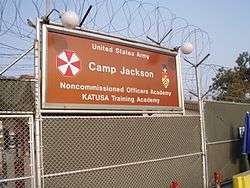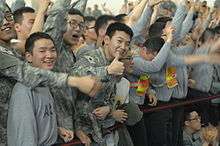Korean Augmentation To the United States Army
| Korean Augmentation To the United States Army KATUSA 대한민국 육군 카투사 | |
|---|---|
 Eighth United States Army shoulder sleeve insignia | |
| Active |
July 1950 – present (68 years, 3 months) |
| Country |
|
| Part of |
Eighth United States Army |
| Motto(s) | Solidarity (Korean: 단결) |
| Engagements | Korean War |


Korean Augmentation To the United States Army (KATUSA[1] Korean: 카투사) is a branch of Republic of Korea Army which consists of Korean drafted personnel who are augmented to the Eighth United States Army (EUSA). KATUSA does not form an individual military unit, instead small numbers of KATUSA members are dispatched throughout the most of the Eighth United States Army departments, filling in positions for the United States Army enlisted soldiers and junior non-commissioned officers. KATUSAs are drafted from pool of qualified volunteers who are subjected to mandatory military service for Korean male citizens. While ROK Army holds the responsibility for personnel management of KATUSAs, KATUSA members are equipped with standard United States Army issues, and live and work with the U.S. enlisted soldiers. This kind of augmentation is unique throughout the entire United States Army worldwide, because KATUSA program was developed during Korean War as a temporary measure to cope with a shortage of personnel in the United States Army.
Purpose
The KATUSA program provides the U.S. military with Korean-speaking soldiers, allowing greater military functionality and maneuverability throughout the Korean peninsula. KATUSA soldiers are assigned to each Eighth United States Army units with their Military Occupational Specialty like the United States Army soldiers and do the part of their MOS. On top of that KATUSA soldiers serve as translators between the local populace and the U.S. Army, and help the U.S. maneuver in unfamiliar terrain. Informally, they help U.S. soldiers new to the peninsula understand Korean customs and a bit of the language. It saves the U.S. money and manpower, and symbolizes the two nations' friendship and mutual support. The KATUSA program remains essential for the safety of the Republic of Korea, not only for establishing partnerships with American Armed Forces, but to learn from each other and to assist each other, especially with the threat of North Korea looming over South Korea. According to Richard Weiz (2013), author of "An Enduring Partnership: South Korea and the United States", The North Korean threat continues to provide the fundamental basis for the ROK-U.S. security relationship…The most recent period of tensions flared up after the North’s long-range rocket launch in December 2012 and underground nuclear test in February 2013" (Pg. 310).[2] Providing valuable information on the peninsula as well as translations, KATUSA soldiers carry out their MOS effectively, allowing for a future of more foreign cooperation with America. Nirav Patel and Lindsey Ford (2009), authors of "The future of the U.S.-ROK alliance: global perspectives" go on to state that "The alliance between the United States and the Republic of Korea (ROK) has been a key component of America’s bilateral alliance system in Asia for almost 60 years. South Korea has been a close friend and valued partner during difficult circumstances, even when personal relations between U.S. and ROK leaders were at a low ebb"[3][4]
History
The KATUSA system was established in July 1950 during the Korean War. It was started as a spoken agreement between President Seungman Lee and U.S. General Douglas MacArthur. At that time, the U.S. Army needed a military force that had the proper knowledge of the geography of Korea, and the abilities to distinguish ally troops (South Korea) from enemy troops (North Korea) and communicate better between U.S. soldiers and Korean soldiers. Therefore, some were drafted to KATUSA by force, and others voluntarily (by their own choice) applied . After training, they were divided into the U.S. military, such as 2nd, 7th, 24th, 25th divisions. During the Korean Wars, a total 43,660 KATUSA soldiers fought for South Korea with U.S. forces. Of these soldiers, 11,365 went missing or were killed in action. This program continued after the Korean War, and KATUSA soldiers would spend 18-months with the U.S. Army learning his occupation and would then return to the ROK Army for training others on the occupation. According to the Eighth Army Wightman NCO Academy, "With the establishment of the ROKA Training Center in 1963…KATUSA soldiers began to spend their whole military tour in the U.S. Army"[5]
KATUSA Code of Conduct
| “ | As a member of the Republic of Korea Army augmented to the Eighth United States Army, I will sacrifice myself to defend my country and her principles. I vow to abide by the following Code of Conduct for unification and honour of my country:
|
” |
Selection process
To become a KATUSA, eligible Korean draftees who've demonstrated a minimum level of English-language proficiency by achieving minimum passing scores on standardized tests of English (TOEFL and TEPS), may apply through the Military Manpower Administration(MMA), upon which their name is entered into a lottery system. Typically, the minimum scores for getting into the lottery are 780 and over for TOEIC and 690 and over for TEPS. As the selection process is completely random, all eligible candidates have an equal chance of winning. Applicants may only apply once.
Qualified Korean draftees who demonstrate a high level of English fluency and aptitude via a standardized written exam (usually the TOEIC) may apply for a KATUSA slot. Conscripts with qualifying test scores are selected on a random basis via lottery by the Korean government. Once selected, KATUSAs must complete six-weeks of ROK Army basic training. A brief orientation and OJT is conducted by the U.S. Army before they begin their full-time duty with a United States Army unit garrisoned in Korea for the duration of their military service.
The number of candidates vying for an available opening is extremely high because many soldiers believe that the U.S. Army is less abusive and more professional in its training and treatment of soldiers compared with the ROK Army, and that junior enlisted personnel receive better treatment, have more educational opportunities (especially with regards to learning English), experience a higher standard of living, and have an overall better quality of life than their ROK counterparts. In 2012, roughly 3,400 KATUSA soldiers served with 25,000 United States Forces Korea (USFK), versus 4,800 in 2005 and 11,000 in 1968.[7] As the number of U.S. soldiers in South Korea decreases, the number of KATUSA soldiers is decreasing as well. The ratio of KATUSA soldiers to U.S. soldiers is roughly 1:10.
U.S. Air Force
While many Republic of Korea Air Force members in Korea work alongside U.S. Air Force members, there is no KATUSA program with the USAF counterpart; ROKAF retains their own unit and command structure separate from their USAF counterparts.
Criticism
Because KATUSA program was built as a temporary measure during mid-war and stayed in that way, there has been no legal legitimation for the program in Korean law system to this date. The oral agreement between General MacArthur and President Rhee on conscripting Korean civilians for the U.S. Forces was never documented. Only the memorandum of assigning operational command of ROK Army to General MacArthur by President Rhee, known as Pusan Letter, is considered as an only justification for KATUSA program in South Korea. EUSA designates the state of KATUSA program in Army in Korea Regulation 600-2.[8]
Since KATUSA soldiers do not undergo special education for their MOS before their deployment and their mission trainings heavily rely on OJT from senior to junior KATUSAs, new KATUSAs usually take a few months of incubatory period before they can fully perform.

One criticism of the KATUSA program arises from the difference in promotion systems; the ROK Army promotes its enlistees on a quota/time basis and not through the merit system. A KATUSA soldier may be senior in rank to an American counterpart with significantly more field experience. However, this criticism is usually rebutted by the counter-argument from the United States Forces Korea that such promotion of KATUSA soldiers is sufficiently warranted given the fact that KATUSA soldiers usually possess at least two years of college experience, which would translate to an advanced enlisted rank for US soldiers.
Another criticism arising from the Korean Army side is based on the fact that most of the KATUSA soldiers are from the top universities in Korea. For the ROKA, this means that they are losing intelligent soldiers to the US Army. To minimize this, the selection process now randomly picks soldiers from the pool of applicants, instead of hiring the most qualified soldiers.
The selection process requires applicants to submit their English proficiency test scores as a mandatory document, and driver's license and computer software proficiency test scores such as Microsoft certificates to quality applicants who are eligible to be drivers or administrators. These measures were introduced to diversify the pool of applicants throughout Korean Army soldiers, but lot of intelligent soldiers still enlist as a KATUSA for superior facilities and treatments. Holistic and random approach is used to quality candidates into different units, and these variety of exam results seem to affect significantly into which positions each applicant is located.
Some of the recent criticisms from the South Korean side include alleged forced-recruitment during the 1950-53 Korean War, when the 7th Infantry Division commandeered reinforcements for the landing at Incheon. These so-called "First KATUSA soldiers" included 313 men from Busan. (The South Korean side claims they were taken from refugee camps, but whether they volunteered or were coerced remains a matter of dispute.)
The KATUSA System was created in the 1950s during the Korean War in accordance with an informal oral agreement between President Seung Man and MacArthur Far East United Nations Commanders, but there is no legal basis for the system.[9]
See also
- KATCOM, a similar system operating in the 1st Commonwealth Division.
References
- ↑
"Abbreviations" (PDF). U.S. Department of State. 29 September 2006. p. 3. Archived from the original (PDF) on 8 August 2009. Retrieved 2009-03-14.
KATUSA, Korean Augmentation To the United States Army
- ↑ Weiz, Richard (2013). "An Enduring Partnership: South Korea and the United States". Korean Journal of Defense Analysis. 3 (25): 301–315. See p. 310.
- ↑ Patel, Nirav; Ford, Lindsey (2009). "The future of the U.S.-ROK alliance: global perspectives". Korean Journal of Defense Analysis. 4 (21): 401–416. doi:10.1080/10163270903298884.
- ↑
"Eighth United States Army (EUSA)". GlobalSecurity.org. 27 December 2005. Retrieved 2009-03-14.
The KATUSA Program is significant not only because of the military manpower and monetary savings that it provides to the U.S. Army, but also because it represents ROK/U.S. cooperation and commitment to deter war. The KATUSA Program is also symbolic of ROK/U.S. friendship and mutual support.
- ↑ "KATUSA Training Academy (KTA)". Eighth Army Wightman NCO Academy. EUSA.
- ↑ "KATUSA Creed". 8th U.S. ARMY. 31 October 2011.
- ↑
then Lieutenant General B.E. Spivy for The Joint Chiefs of Staff (21 February 1968). "Increase of US Army Forces in Korea (JCSM-112-68)" (PDF). Retrieved 2009-03-14.
...15,000 ROK personnel, 11,000 of whom are Korean augmentation to U.S. Army (KATUSA soldiers) personnel integrated into US units.
Declassified 1 Nov 94 - ↑ "REPUBLIC OF KOREA ARMY PERSONNEL WITH THE ARMY IN KOREA" (PDF). 8 May 2013.
- ↑ "ILLEGAL dispatch, KATUSA COME BACK HOME" (in Korean). h21.hani.co.kr. Retrieved 2017-09-01.
Further reading
- Appleman, Roy. South to the Naktong, North to the Yalu: June–November, 1950 (1961).
- Blair, Clay. The Forgotten War: America in Korea, 1950-1953 (1987).
- Hermes, Walter. Truce Tent and Fighting Front, United States Army in the Korean War (1966).
- Mossman, Billy. Ebb and Flow: November 1950-July 1951 United States Army in the Korean War (1990).
- Skaggs, D.C. The KATUSA Experiment: The Integration of Korean Nationals into the U.S. Army, 1950-1965 (1974).
- Stanton, Shelby. American’s Tenth Legion, X Corps in Korea, 1950 (1989).
- The Korean War: An Encyclopedia, edited by Stanley Sandler and published by Garland Publishing, Inc.
External links
| Wikimedia Commons has media related to KATUSA. |